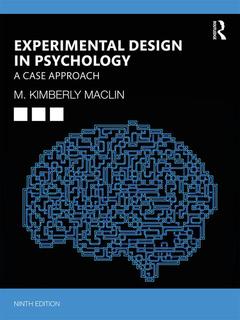Experimental Design in Psychology (9th Ed.) A Case Approach
Auteur : MacLin M. Kimberly

This text is about doing science and the active process of reading, learning, thinking, generating ideas, designing experiments, and the logistics surrounding each step of the research process. In easy-to-read, conversational language, Kim MacLin teaches students experimental design principles and techniques using a tutorial approach in which students read, critique, and analyze over 75 actual experiments from every major area of psychology. She provides them with real-world information about how science in psychology is conducted and how they can participate.
Recognizing that students come to an experimental design course with their own interests and perspectives, MacLin covers many subdisciplines of psychology throughout the text, including IO psychology, child psychology, social psychology, behavioral psychology, cognitive psychology, clinical psychology, health psychology, educational/school psychology, legal psychology, and personality psychology, among others. Part I of the text is content oriented and provides an overview of the principles of experimental design. Part II contains annotated research articles for students to read and analyze. Classic articles have been retained and 11 new ones have been added, featuring contemporary case studies, information on the Open Science movement, expanded coverage on ethics in research, and a greater focus on becoming a better writer, clarity and precision in writing, and reducing bias in language.
This edition is up to date with the latest APA Publication Manual (7th edition) and includes an overview of the updated bias-free language guidelines, the use of singular "they," the new ethical compliance checklist, and other key changes in APA style. This text is essential reading for students and researchers interested in and studying experimental design in psychology.
Part I: Basic Principles in Experimental Design
Chapter 1. An Introduction to Scientific Inquiry
Chapter 2. The Psychological Literature: Reading for Understanding and as a Source of Research Ideas
Chapter 3. Basic Experimental Design in Psychology
Chapter 4. Advanced Design Techniques
Chapter 5. Using Experimental Design to Control Variables
Chapter 6. Control of Subject Variables
Chapter 7. Design Critiques
Chapter 8. Ethics of Experimental Research
Chapter 9. The Research Process
Part II: Analysis of Experiments
Chapter 10. The Look of Love
Chapter 11. Emotions and Chronic Fatigue
Chapter 12. Temperature and Loneliness
Chapter 13. Violent Media
Chapter 14. Aggression and Schizophrenia
Chapter 15. Workplace Deviance
Chapter 16. Controlling Racial Prejudice
Chapter 17. Children’s Reasoning
Chapter 18. False Confessions
Chapter 19. Androgens and Toy Preferences
Chapter 20. Language-Trained Chimpanzees
Chapter 21. Peer Excellence and Quitting
Chapter 22. Remembering and Eyes
Chapter 23. Non-Suicidal Self-Injury
Chapter 24. Police Responses to Criminal Suspects
Chapter 25. Sleep Learning
A Final, Final Note
Appendix A: Computational Procedures for Basic Statistics
Appendix B: Statistical Tables
Glossary
References
Name Index
Subject Index
Kim MacLin, PhD, is a Professor of Psychology at the University of Northern Iowa. She has won several awards including the State of Iowa Board of Regents Award for Faculty Excellence in Research, Teaching, and Service. Previous editions of Experimental Design in Psychology: A Case Approach (formerly Experimental Psychology: A Case Approach) have been translated into Arabic, Chinese, Korean, Turkish, and Russian.
Date de parution : 03-2020
19.1x25.4 cm
Ancienne édition
Accéder à la nouvelle édition.
Date de parution : 03-2020
19.1x25.4 cm
Ancienne édition
Accéder à la nouvelle édition.
Thème d’Experimental Design in Psychology :
Mots-clés :
Young Man; NSSI History; experimental psychology; Saccade Trajectories; experimental design; Non-suicidal Self-injury; psychological science; NSSI; scientific methodology; Michigan State University; hypothesis development; Open Science Movement; correlational studies; observational methods; Vice Versa; psychological literature; National Academy; electroninc databases; Sleep Learning; big data; Random Assignment; indexing; Experimental Brain Research; reading psychology articles; CAH Girl; psychology journals; Peer Assessment; independent variables; Functional Assessment; dependent variables; Aba Design; control groups; Cfs Participant; experimental groups; HADS Anxiety; functional design; Cfs Group; generalization of results; Workplace Deviance; experimental results; HADS Depression; experimental findings; Color Singleton Target; Continuous EEG Monitoring; matching subjects; Sex Typed Toy Preferences; design critiques; experimenrt briefs; ethics and research; ethics and experimental design; codes of conduct; research with human; research with animals; case studies; writing a research paper; reporting data; writing a manuscript; submitting a manuscript; poster sessions; conferences; analysis of experiments; field based studies; child psychology; cognitive psychology; behavioral psychology; social psychology; experimental design psychology



